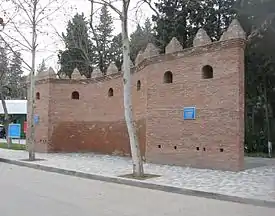Ganja Fortress
Fortress of Ganja (Azerbaijani: Gəncə qalası), is a fortress in Ganja, Azerbaijan. The remains of walls of the fortress can be seen in the territory of the oldest park of the city, Khan's Garden and in the entrance to the city, along the Ganja River.[1]
| Ganja Fortress | |
|---|---|
Azerbaijani: Gəncə qalası | |
 The preserved part of the fortress, built in the XVI century in "New Ganja" | |

| |
| General information | |
| Type | Fortress |
| Architectural style | Architectural school of Arran |
| Address | Gala Street |
| Town or city | |
| Country | |
| Completed | 3 September 1588 |
| Client | Murad III Farhad Pasha |
| Technical details | |
| Material | Brick |
History
Farhad Pasha who headed the Turkish army in the Caucasus went to Ganja, controlled by the Safavids, by the order of Sultan Murad III.[2] Ganja was captured on September 1, 1588. After taking Ganja, on 3 September 1588, Farhad Pasha ordered the construction of the castle 7-8 kilometers from the city. About forty days later the castle was built 2.3 km in length and 6 m in height 1.8 m in thickness of the walls.[3] It was built in a flat area and was built on the left bank of the Ganja River.[2] Ganja, where divided into 4 parts with the fortress in XVI century, consisted of four parts: Outer city, Shahristan, Ichgala and Naringala.[3]
In 1868, after Ganja became the regional center of the Caucasus a new master plan of the city was prepared by architect Ignati Kshishtalovic. After the master plan approved in 1873 by Alexander II, walls of the fortress were demolished and European-styled neighborhoods were built.[1] At present, a very small part of the Ganja fortress, Shiralibey tower remains. In 2007, restoration works were carried out on this fortress wall.[3]
Architectural features
While building the castle, some neighborhoods of Ganja were kept outside the walls of the fortress.[3] It was built in an uneven polygonal shape. In the construction of the fortress, clay-mud, cobblestones and baked red bricks which is traditional Ganja architecture, were used. For that reason Its south-west, north-west, and north-east walls were strong. The total length and height were 13.7 km and 12 m respectively. A total of 30 defensive towers were built across the wall every 200 to 500 meters.[1]
At certain height of the fortress walls, embrasures and watchtowers were constructed. They were important to use to attack the enemy. From those places, local fighters used to spill boiling oil and lubricant on attacking enemies.[2]
Gallery
| Remains of internal walls of the fortress | |||
|---|---|---|---|
_1.JPG.webp) |
.JPG.webp) |
_4.JPG.webp) |
_5.JPG.webp) |
References
- "Azərbaycanın Şamaxıdan Naxçıvanadək 6 əfsanəvi qalası" (in Azerbaijani). news.day.az. Retrieved 16 February 2018.
- "Əsrlərin sədası – Gəncə qalası" (in Azerbaijani). portal.azertag.az. Retrieved 16 February 2018.
- "Gəncə qalası" (in Azerbaijani). globalnews.az. Retrieved 16 February 2018.
